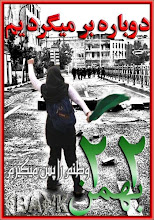




.jpg)
Pictures Continued
This post continues to look at the way images are used to build the story of Iran’s resistance to its current tyrannical regime. In the post below, I introduced the story, such as it is, of Taraaneh Mousavi, whose image has become so closely associated with the campaign to expose and indict the perpetrators of rape as a method of torture, of social control and, in some instances, of death, in prisons and police stations across Iran.
The Story And The Life
The post below attracted two comments, one of which states that, ‘a healthy dose of scepticism’ is required when reading the stories of Taraaneh for which the writer provides some links, which, I have to say, leave me none the wiser. I am aware of the highly contested nature of this story and I do want to emphasise again, that in this series of posts, I am not so much concerned to set out the facts of the lives of the three individuals named below, there are others far better placed to do this, but rather to set out the story. I am differentiating here between ‘truthful’ reportage or ‘documentary truth,’ and an examination of how a story grows, why it grows, what its meaning is and how this is built through imagery and the use of those images. Whatever the evidence of the life and death of Taraaneh Mousavi ultimately reveals, and my strong feeling is most of us will never know for sure what happened, what is beyond question is the strength and nature of the feeling the story has aroused and what meanings have become attached to it. Like it or not, it is now and probably forever, the single image that most frequently appears associated with rape-to-kill and rape as torture. The collection of images above are all from one jonbesh e sabz demonstration in London, outside the Iranian Embassy, on Sunday 23rd August 2009, (photo credits Iman Nabavi).
A Sign
In the case of all three individuals introduced in post below - Neda Agha Soltani, Taraaneh Mousavi and Sohrab Araabi, the image has already started to part company with the life of the woman or man represented. This is more obviously the case with Neda and Taraaneh, as I think is clear from the story of ‘Neda the Christian martyr’ which can be seen in the proliferation of blogs which emphasise her crucifix, and in Taraaneh, whose highly formalised, almost impersonal image, lends itself so well to the notion that ‘this might happen to any of us.’ I think, and I hope it is not too harsh to suggest it, that she is almost more of a signifier of a ‘victim of the worst excesses of the Islamic Republic’ rather than a real woman from whom we might then differentiate rather than identify ourselves. Sohrab Araabi is usually pictured as 'the protester hero,' the beautiful young man cut down in his prime. My guess is this is how he'll stay. I assume he was many other things too, not just a protester but, as far as his image is concerned, he has now become, 'any (male) protester.'
What Counts As Rape
I should also add that, in spite of my searches of the life of Taraneh Mousvi, I am still not clear what part of her story is seriously contested. There doesn’t seem to be any doubt that she was raped or that she is dead, or that the two are in some way connected. There are endless questions concerning who when where and why which could be the source of the doubt. A possible interpretation of this may be connected with how rape is constituted legally, socially and morally – in other words: what counts as rape. English readers will be very familiar indeed with this since it regularly arises here in the form of ghastly, legalistic expressions such as, ‘she was guilty of contributory negligence,’ which means she was out on her own late at night, or was wearing a short skirt or was drunk or some such thing. The equally offensive offering is, ‘she was asking for it,’ or ‘she was a prostitute,’ which apparently means she can’t be raped because prostitute women ‘don’t count.’ In short, the entire discourse of rape in Iran has many parallels to the discourse here in England. The whole notion of rape is subject to disbelief and blame. This of course makes it even more likely that this image will be forever attached to the Iranian rape-in-prison, rape-to-kill reports, precisely because, as always, it is contested. The story can reasonably be said to be typical - it is ‘any woman’ and, in this case, ‘any man.’
















































